Medzhybizh Fortress
Medzhybizh Fortress (Ukrainian: Меджи́бізька фортеця, Medzhybiz'ka fortetsia) also known as Medzhybizh Castle (Ukrainian: Меджи́бізький замок, Medzhybiz'kyi zamok), is situated at the confluence of the Southern Bug and Buzhok rivers, in the town of Medzhybizh (Polish: Międzybóż), Ukraine. Today the castle is part of the State Historical and Cultural Reserve.
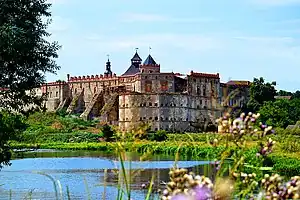
History of the place

The first fortification on a high cape located near the confluence of the Buzhok and Southern Bug rivers dates back to the period of Kyivan Rus'. Medzhybizh town was first mentioned in historical chronicles in 1146, but archaeological findings on the territory of the castle show that the town existed much earlier. In the XIII century Medzhybizh was part of the Bolokhiv land, and at that time there was a wooden fort on this place. It was dismantled by Daniel of Galicia in 1255. The first stone castle was built here during the time of the Grand Duchy of Lithuania (XIV century), when the Koriat's owned the Podolia land. Some buildings of the Lithuanian period were preserved under the buildings of the following periods. Since 1540, Medzhybizh castle and town was the property of hetman Mikołaj Sieniawski (1489-1569) and his descendants. Then the size of the castle was increased to the perimeter of the modern territory. In 1672-1699, during the occupation of the Podolian Voivodeship by the Turks, the castle housed a Turkish garrison. Since 1731, as a result of his marriage to Countess Maria Zofia Sieniawska, the castle became the property of prince August Aleksander Czartoryski and their descendants as part of the dowry. In the 18th century the castle lost its important military purpose and turned into one of the provincial residences of the Czartoryski family. In 1790-1791, Tadeusz Kosciuszko was the chief of the Medzhybizh garrison. After the second division of the Polish-Lithuanian Commonwealth (1793) and the annexation of the Podolian Voivodeship, Medzhybizh passed to the Russian Empire, but remained the property of the Czartoryski family. In 1819, prince Adam Jerzy Czartoryski opened a school in the castle for children of the local nobility. For this, the castle was slightly rebuilt, as a result of which it acquired neo-Gothic stylistic features. For participation in the November Uprising of 1830-1831, the castle was confiscated along with all the Czartoryski estates. Since 1848, Czartoryski castle was handed over to the Ministry of War of the Russian Empire. From 1896 to 1914, officers of the 12th “Okhtyrski” hussar regiment were stationed in Medzhybizh castle. During the Soviet period, the castle was used for economic needs, and in the 1950s it was partly destroyed. In 1963, the castle was given the status of an architectural monument.
List of landmarks
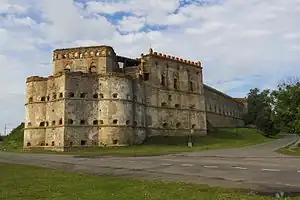

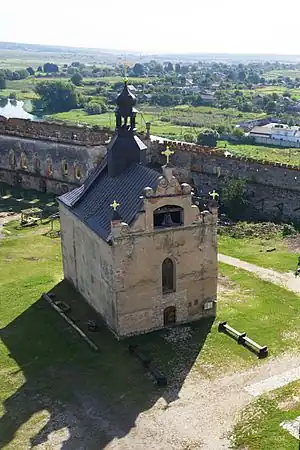
The Palace of the Sieniawski and Czartoryiskyi families was built in the 16th century as a complex of residential, defense and economic buildings. The current palace in the Renaissance style was built over the previous buildings of the period of the Grand Duchy of Lithuania. From that time, the central tower (donjon), the barbican, part of the southern tower and the western wall, below ground level have survived. The palace complex also includes the eastern and western wings of the 16th-19th centuries, a three-tier bastion of the 16th century. The style of architectural decoration of the palace has analogues among the Renaissance palace buildings of South-Eastern Europe, in particular Slovakia. Since the most famous owner of Medzhybizh castle Mikołaj Sieniawski (1489-1569) was a Calvinist, the attic of the newly built palace contains characteristic symbols of Protestantism (stylized communion cups and others). The structure of the buildings preserved elements of the previous construction stages (before the 16th century). As a result of partial reconstruction in the 19th century the palace acquired Neo-Gothic architectural elements.
Church of the XVI-XIX centuries. It was built in 1586 (according to other sources in 1591) as the castle chapel of St. Stanisław in honor of the return of the Sieniawski family to Catholicism. During the Ottoman occupation (1762-1699) it was used as a mosque. In the second half of the 19th century, it was reformed into an Orthodox church for the military. In the Soviet period, before the monument status was granted, it was used for economic purposes. In 2005, the building was handed over to the Ukrainian Orthodox Church of the Kyiv Patriarchate and restored. Currently, the church operates as the Orthodox Church of Ukraine.
Walls and towers of the XIV-XIX centuries. The pentagonal tower named "Knight's" has four floors. It was built in the 16th century or earlier. The tower named "Officer's" has an octagonal shape. It was built of brick in the 18th and 19th centuries over an earlier stone roundel, with a castle well in its center. The southern rectangular tower (XVI-XIX centuries) contains a fragment of the half tower, which has been preserved from the time of the Grand Duchy of Lithuania (XIV century). The southern curtain wall (XVI-XIX centuries) has embrasures for a four-tiered wooden battle parapet. In the western curtain wall from the 16th century there is an fortified gateway with an arched bridge over a dry moat. The bridge has one lifting section, which was raised by chains. The piers of the bridge stand on an earlier stone defensive structure, which is hidden under a layer of earth. The carriage house or stable, which is adjacent to the western curtain wall, had an economic purpose. Next to it is the residence of the commandant of the castle. Single-storey residential buildings dating from the 18th century adjoin the northern and northeastern curtain walls. Now there are museum exhibitions and service premises of the reserve.
Notable people
Historical and Cultural Reserve “Mezhybizh”
The first documentary mention of the museum in Medzhybizh castle dates in 1819 (the owner of the castle at that time was prince Adam Jerzy Czartoryski). The status of an architectural monument was assigned to Medzhybizh castle on March 26, 1963. Medzhybizh castle was entered into the category of "Landmarks and Architecture Monuments" of the State Register of National Cultural Heritage on July 2, 1999 (protection No. 746). In 1971, the first modern museum exhibition was opened as a department of the Khmelnytskyi Regional Museum of Local History. In 1997, it was reorganized into the Medzhybizh regional historical and ethnographic museum-fortress. In accordance with the resolution of the Cabinet of Ministers of Ukraine dated 27.12.2001, the State Historical and Cultural Reserve “Mezhybizh” was created. In fact, the reserve started its activities in 2003. The name of the reserve "Mezhybizh" (without the letter d) corresponds to the name of the town of Kyivan Rus' times: "Mezhybozhe". Since 2020, Medzhybizh Castle has been an associate member of the European Cultural Route of FORTE CULTURA e.V. In April 2022, at the annual international conference in Terezin, Medzhybizh Castle was granted the status of official stop on the European Cultural Route FORTE CULTURA.
Activities
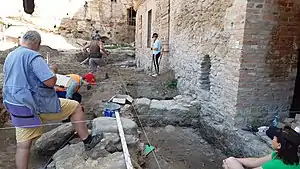
Since 2009, scientific and local history conferences "Ancient Medzhybizh in the historical and cultural heritage of Ukraine" have been held annually in the reserve "Mezhybizh", since 2011 "Archaeological readings" have been held annually, since 2015 international archaeological conferences have been held once every 2 years together with Institute of Archaeology of the National Academy of Sciences of Ukraine. Since 2002, annual festivals of historical reconstruction have been held. Since 2015, the annual "Night of Museums in Medzhybizh castle" events have been held here. Since 2016, the international volunteer archaeological camp "Medieval bastion" has been operating annually. The reserve publishes the journal "Scientific Bulletin "Mezhybizh", the book series "Archaeological Studies "Mezhybizh", other publications.
Gallery
- Views of the fortress
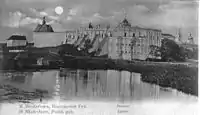 Międzybuż on a 1900 postcard
Międzybuż on a 1900 postcard The wall
The wall One of the castle's four towers
One of the castle's four towers_DSC_1062.JPG.webp) St.Nicholas Church
St.Nicholas Church A recently restored 16th-century church
A recently restored 16th-century church
References
- Межибіж Archived 2018-09-09 at the Wayback Machine / Ігор Западенко // Енциклопедія сучасної України. — 2018.
- Zapadenko I. Medzhybizh castle in the 1760th years inventories (Меджибізький замок в інвентарях 1760-Х років). // Current issues in research, conservation and restoration of historic fortifications. — 2022. — № 17. — s. 79-113.
- Zapadenko I., Leskiv I. About the «turkish fortifications» of Medzhybizh 1672-1699 in the context of the documentary chronology of the Ottoman claims for Podillya (До питання про «турецькі фортифікації» Меджибожа 1672-1699 р. у світлі документальної хронології османських претензій на Поділля). // Current issues in research, conservation and restoration of historic fortifications. — 2022. — № 17. — s. 53-62. https://doi.org/10.23939/fortifications2022.17.053
- Zapadenko I. Arhitekci zamku w Międzybożu w ostatniej połowie XVI wieku Jan Bąk i Krzysztof Bodzan. Źródła przeciwko mitom. // Current issues in research, conservation and restoration of historic fortifications. — 2023. — № 18. — s. 140-147. https://doi.org/10.23939/fortifications2023.18.140
External links
- Official website of the State Historical-Cultural Preserve "Medzhybizh"